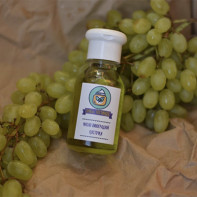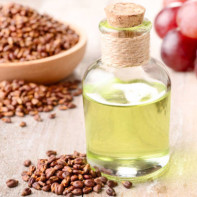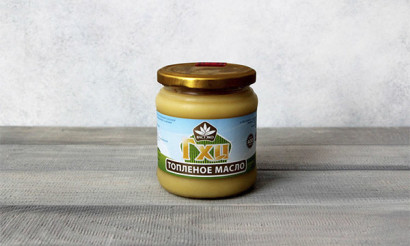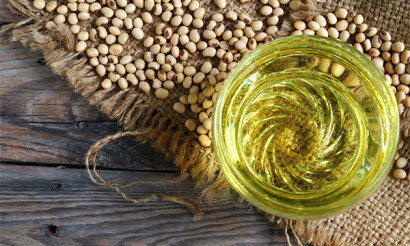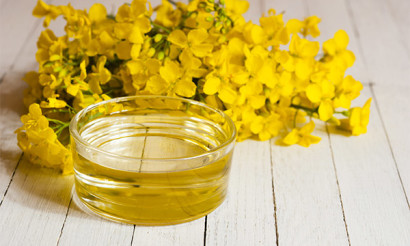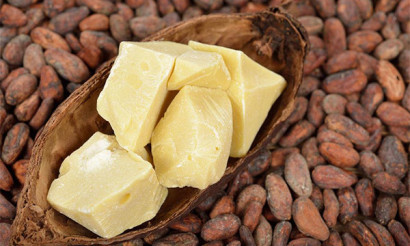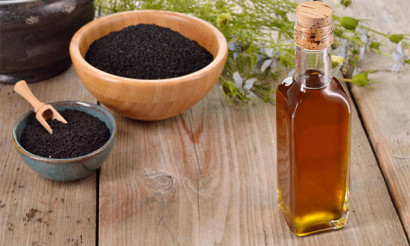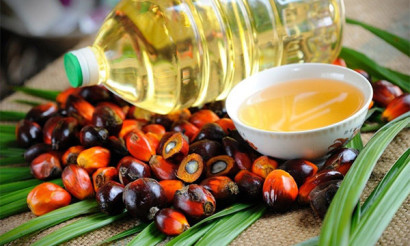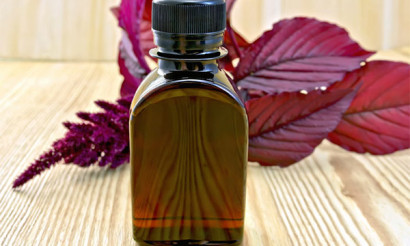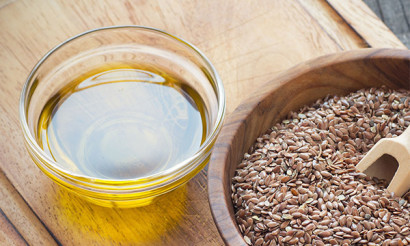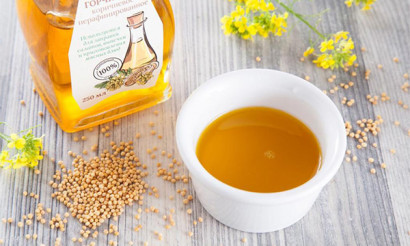Grape seed oil: useful properties and contraindications
Grape seed oil is a unique product with medicinal properties. On the one hand, it is just a byproduct of the wine industry, but on the other hand - a valuable raw material for food, cosmetics and even pharmaceutical industries. Viscous light yellow liquid with a greenish tint - this is how grape seed oil looks like. It has a pleasant taste and contains many vitamins.
- Composition and calories
- Useful properties of grape seed oil
- For Women
- For Men
- In Pregnancy
- For children
- Slimming
- How to ingest grape seed oil
- Grape seed oil in medicine
- Diabetes mellitus
- For gastritis
- For gout
- For Liver
- Grape seed oil in cosmetology
- For Face
- For hair
- For eyebrows and eyelashes
- Grape seed oil in cooking
- Can I fry on grape seed oil?
- Hazards and contraindications
- How to choose and store
- How to make grape seed oil at home
- Interesting facts about grapes
Composition and calories
The energy value of this oil largely depends on the properties of the initial raw material and on average is 884-899 kcal per 100 ml, which is quite comparable with the indicators of sunflower and vegetable oils.
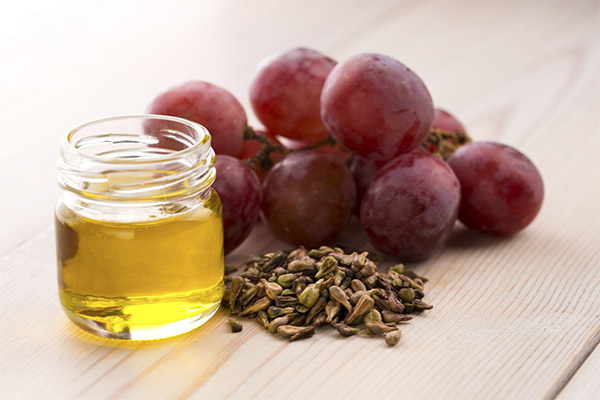
However, grapeseed oil has one important advantage. It is very high in linoleic acid, which is responsible for lowering blood cholesterol levels, preventing high blood pressure and slowing the development of heart disease. On average, this product contains 72% linoleic omega-6 unsaturated acid. The rest is oleic acid (Omega-9 unsaturated - up to 16%), palmitic, stearic and alpha-linolenic acids.
It is the combination of linoleic and oleic acids plays an important role, because together they determine the anti-inflammatory effect of the product. It has a beneficial effect on the CNS and endocrine system, helps to cleanse the body of all kinds of toxins.
Also this oil contains vitamins A, E and B group, ascorbic acid, almost the same set of macro- and microelements, flavonoids, polyphenols and phytosterols as grapes.
Useful properties of grape seed oil
This unique product contains many useful components. They help fight swelling, improve night vision, have a beneficial effect on the condition of blood vessels and eliminate hemorrhoids. This oil is used in the complex treatment of many diseases. And modern studies have shown that it can, if not prevent, then slow the growth of malignant tumors of the intestine, breast or prostate.
For women
For women, this oil is useful because of the presence of phytosterols. These are hormone-like substances that, unlike synthetic hormone replacement therapy, have no side effects. The presence of these substances allows the use of grape seed oil in the treatment of diseases caused by hormonal imbalance. So, it helps well in the menopausal period and in the presence of painful PMS. In addition, the oil has a beneficial effect on blood vessels, which makes it effective in the treatment of varicose veins. It is also used directly for the prevention of infectious and inflammatory diseases of the pelvic organs. And in general, its use has a beneficial effect on all organs of the reproductive system.
Also grape oil helps to take care of the skin, nourishes it, makes it smoother and softer. Studies have shown that the use of this product helps to prevent or even eliminate stretch marks, get rid of fine lines.
For Men
Grape seed oil contains a complex of substances that have anti-inflammatory activity, improve spermatogenesis and increase erectile function. This is especially important for modern men, who often suffer from the effects of chronic stress and sedentary lifestyle. These substances include the polyunsaturated fatty acids listed above, B vitamins, tocopherol, and beta-sitosterol.
It is useful for men as a therapeutic and preventive agent to introduce grape seed oil into the diet. It is considered effective in such problems as male infertility, prostatitis, adenoma, and even prostate cancer (which does not negate the use of potent drugs).
When pregnant
In the diet of the future mother must be present Omega-6 unsaturated fatty acids. And the grape oil is considered to be their best source. In addition, it provides a pregnant woman with all the necessary vitamins and trace elements. Some of its constituents even have bactericidal properties, which is also very important during pregnancy.
However, expectant mothers will probably be interested in another property of linoleic acid. It is responsible for skin elasticity and its ability to regenerate. Therefore, during pregnancy, grapeseed oil is applied to the skin to prevent stretch marks.
For children
Children under the age of 12 years old are not recommended to give grape seed oil, because in the same way as the grapes themselves, it can cause food allergies. The exception is when there is an appropriate medical advice - for example, in inflammatory joint disease, it can be used as a topical remedy, and for diabetes include it in the diet of 1 tsp. per day.
For weight loss.
Linoleic and oleic acids contained in this oil, normalize lipid metabolism and improve the function of the endocrine system. That is why this product is useful for weight loss - of course, if it is combined with a proper diet. For example, if a person is on a diet, this type of oil can be used as a dressing for vegetable salads in the diet. By the way, it promotes better absorption of antioxidants such as vitamins A and E.
How to ingest grape seed oil
This product is used as an external and internal remedy. If we are talking about taking it internally for therapeutic purposes, the dosage is 20 ml (2 tablespoons) per day. The duration of the course is 30 days. To make it easier to take this amount of oil, you can drink apple juice (if the patient has no gastritis).
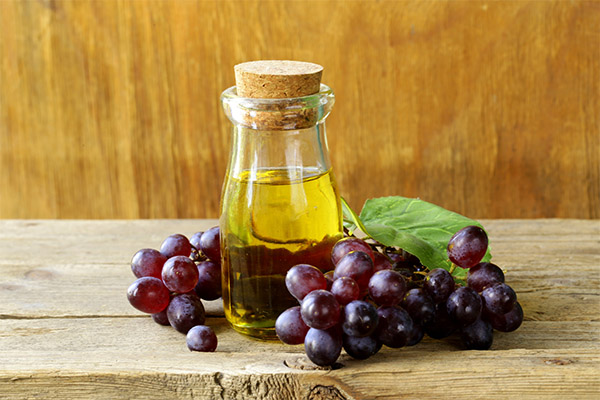
If we are talking about the use of the inside as part of various dishes, then here the norm is 2-3 tbsp. oil per day.
If the oil is taken in the prevention and restorative purposes, the rate - 1 tbsp. means on an empty stomach. Course duration - 2 weeks.
Grape seed oil in medicine
In official medicine, grape seed oil is considered as a useful food supplement. It has no independent therapeutic value, but is an important part of a comprehensive approach to treatment.
Diabetes mellitus
It is believed that because of its high content of organic acids and grape polyphenols, this oil is useful not only for obesity, but also for type 2 diabetes, because it lowers blood glucose levels.
Important: The glycemic index of grape seed oil is 54 units.
Gastritis
With gastritis with high acidity, this oil is useful because it relieves inflammation of the mucous membranes of the stomach, promotes their regeneration. But it should be used in small amounts (2-3 tablespoons) as part of various dishes. And at the same time, products fried in grapeseed oil should not be used with gastritis.
With gout
This disease is manifested by inflammatory processes in the joints, which is caused by disorders of the salt metabolism. Inside, grape seed oil is not used for gout. But as an external agent, it has proven effective.
To relieve pain in the joints, make the following mixture - take 20 ml of grape seed oil, add 4 drops each of essential oils of lavender and eucalyptus, and 5 drops of lemon oil. The resulting remedy is gently rubbed into the painful joint, wrap it with a woolen cloth and give it complete rest. Such procedures can be done daily at night.
For the liver
The composition of grape oil is unique in its hepatoprotective properties, which contributes to the restoration of liver cells. Therefore, if there is no exacerbation of cholecystitis, this oil by 1-2 tsp. can be taken for liver diseases. It should be borne in mind that it also has a choleretic effect, so it can help with certain diseases of the gallbladder, bile stasis.
Grape seed oil in cosmetology
This oil is added both in ready-made cosmetics, as well as in masks and scrubs, prepared at home. Due to its high antioxidant content, it is used for face, body and hand skin care and will also be beneficial for hair and eyelashes.
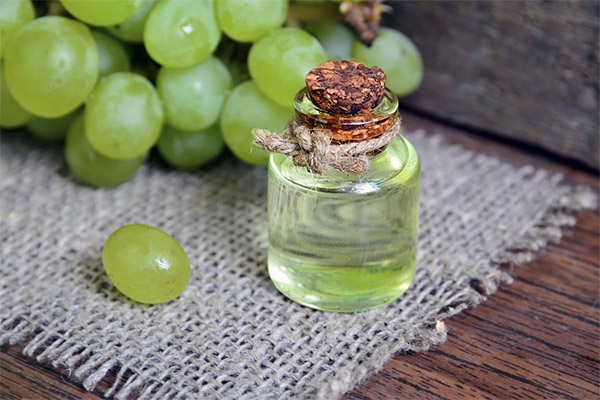
For the face
In general, grape seed oil is used to nourish the skin of the face, but other products are also prepared on its basis. For example:
- Rejuvenating mask. For 15 ml of grape seed oil take 1 tbsp. white cosmetic clay and the same amount of freshly squeezed lemon juice. The mask is kept on the face no longer than 15 minutes so as not to lighten the skin too much, then remove it with a damp napkin.
- A cleansing scrub. For its preparation mix 1 tbsp. grape oil with the same amount of coffee grounds and crushed oatmeal flakes. The product is applied to the skin, massaging for literally two minutes, then holding it like a mask for another 10 minutes and then rinsing it off with warm water. Coffee gives a tonic effect due to the caffeine, flakes and oil provide vitamins.
You can also add a little grape oil to the usual face cream.
For hair
Grape seed oil can be used for a variety of masks because it nourishes the skin and stimulates hair follicles. For example:
- For hair growth and strengthening. For 1 tbsp. ground oatmeal flakes take 20 ml. oil, mix with 1 tsp. table vinegar (although it is better to take apple vinegar, if possible). The remedy is mixed thoroughly, then applied to wet hair after washing. Cover the head with plastic wrap and wrap a towel on top. The mask is washed off after 30 minutes with an ordinary shampoo.
- Mask against greasy hair. Take 4 parts of grape seed oil, 2-3 drops of thyme essential oil (available at pharmacies), add 4 tablespoons of blue cosmetic clay and knead into a thick creamy mixture. Mask applied to the roots and leave for half an hour. Then rinse with cool or warm water. Shampoo at the same time do not need to use.
- Mask against seborrheic dermatitis. Simply put, it is an excellent remedy for dandruff. For it, you take 4 tsp. of oil, pour to them 1 tbsp. of cognac, then mix it with two fresh egg yolks. The resulting mixture is applied to the hair and at the roots and lightly rub into the skin with massaging movements. The rest of the mask can be applied to the entire length of the hair, trying to distribute evenly. After half an hour, you can wash it off with shampoo.
Since grape seed oil can cause individual intolerance, you should first apply a couple of drops on the elbow or wrist and after a few minutes to check the reaction.
For eyebrows and eyelashes
The oil is ideal for the care of eyebrows and eyelashes. You can use it to make the following products:
- Nourishing composition for eyebrows and eyelashes. Mix 1 ml of castor and grapeseed oil, add 1 capsule of vitamin A. It is better to use a special brush for eyebrows and eyelashes, then it will be possible to apply it evenly. The preparation should be kept for 10-40 minutes, depending on the tolerance of this procedure. Then it is washed off with the usual makeup remover.
- Moisturizing mask. Grape seed oil is mixed in equal proportions with the juice of fresh aloe leaves. The resulting product is applied to cotton pads, which are used as a lotions for the eyelids. This composition cares for both eyelashes and the sensitive skin around the eyes, moisturizes them and helps to relieve fatigue.
It is very important to rinse the product completely, otherwise a slight swelling of the eyelids may occur. When applying it, make sure that the oil does not get to the roots of the eyelashes. Otherwise it will get on the mucous membrane, and this can cause irritation. To remove the oil it is convenient to use cotton pads and sponges.
Grape seed oil in cooking
This oil is widely used in cooking due to its remarkable consumer properties. First, it has a high smoke point (+216°C), so it is considered ideal not only for frying and baking, but also for stir-frying. Secondly, it is less dense than olive oil, and from a nutritional point of view it is even healthier, so often grape seed oil is substituted for olive oil in recipes. Even unrefined grape seed oil is clear, almost odorless and has a light nutty flavor. It has almost no influence on the taste of other products, which makes it a perfect base for salad dressings.
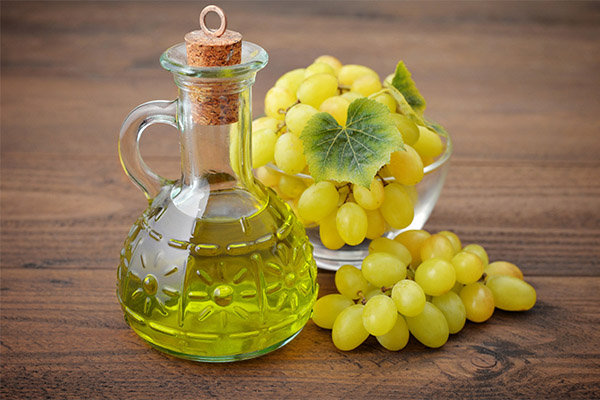
On the basis of grape oil are prepared so-called aromatic oils, which are further combined with meat and fish dishes, various side dishes. For this purpose they take grape seed oil as a base and mix it with minced garlic and any spicy herbs like parsley, basil, oregano.
Grape seed oil can also be used to make mayonnaise at home. Some cooks add a small amount of this oil to vegetables for canning. And, as will be discussed below, it is also used when frying potatoes to get a rich golden color.
Although experimenting with this oil can be endless, there is an opportunity to use ready-made recipes:
- Salad with pear, arugula and cheese. You will need 150 g of arugula, 2 medium hard pears, sheep cheese, the juice of one lemon, nuts, sea salt, black pepper and grape seed oil to taste. Pears are peeled, core removed, cut into thin slices, sprinkled with lemon juice. Spread rucola on a plate, garnish with pear slices and slices of cheese, sprinkle it all with ground nuts and pour grape oil on it.
- Salad with cabbage and prunes. For the preparation we need 300 g of white cabbage, 4 prunes, 1 medium-sized hard pear, 1 small onion, the juice of one lemon, grape seed oil (up to 3 tbsp.). Cut the cabbage into thin julienne strips and the onion into half rings, mix and knead lightly with your fingers. Pears are also cut into julienne strips, sprinkled with lemon juice and added to the other vegetables. Prunes, if they are too hard, soaked beforehand, then cut up. All ingredients are mixed and dressed with grape seed oil.
- Fried potatoes with mushrooms. This dish with grape seed oil gives a richer flavor and a beautiful color. To prepare the dish you will need potatoes (5-6 pieces), 0.5 kg of frozen mushrooms, 2 onions, sea salt and grape seed oil to taste. Onions are parsed in grape oil in a fairly deep pan, add the mushrooms and fry for 5 minutes, then add potatoes chopped in strips to the mushrooms and cook as usual.
- Chicken breasts with orange and ginger. You will need 2 chicken breasts, 1 orange, 2 tbsp. grated ginger root, 2 garlic cloves, 1 tbsp. Grape seed oil, salt, pepper to taste. Chicken breasts are lightly battered and cut into small pieces. Orange zest is mixed with grated ginger. Garlic cloves are heated in grapeseed oil so that the aromatic substances pass into it, and then removed. Pieces of chicken are placed in the oil and fried for 5 minutes, then ginger mixed with the zest is poured on top. After that, the meat is poured with orange juice mixed with 2 tablespoons of soy sauce, and cooked for another 10 minutes.
On the basis of grape oil are prepared marinades for fish and meat, adding various spices characteristic of Mediterranean cuisine. Even mashed potatoes, wheat porridge, couscous or bulgur would benefit from such an addition.
Can I Fry in Grape Seed Oil
Grape seed oil is high in oleic acid. Its chemical composition gives the product a high resistance to heat. Therefore, it is believed that this oil is ideal for frying meat, fish, vegetables, pies, etc.
Harms and contraindications
In general, there are no side effects when using this oil. However, in large quantities when taken internally, it can provoke unpleasant feelings in the stomach, various dyspeptic symptoms.
Grape seed oil has practically no contraindications. The exception is an individual intolerance to its components, both internally and externally. In addition, because of its choleretic effect, it is not used for cholelithiasis and cholecystitis in the acute stage.
How to choose and store
Grape seed oil is produced in all wine-growing regions. The highest quality product is considered to be from France, Italy, Spain and Argentina.
The industry uses two methods to produce this product - hot extraction and cold pressing. The second option is considered to be of higher quality, because cold pressing allows preserving more vitamins and useful substances. However, the yield of the finished product using this method is much lower than that of hot extraction, so in practice this technology is used quite rarely. Nevertheless, if it is possible, it is better to choose cold-pressed oil. The hot extraction destroys some of the useful substances, but still leaves a fairly large amount of vitamins and organic acids.
You should buy oil poured in glass bottles. First of all, this is the only correct way to store it. Secondly, these bottles allow you to see its color. It should be yellow with a greenish hue. But there are also oils with a pronounced green color. This does not indicate that they are of poor quality, but only that a large amount of the plant pigment chlorophyll remains in them, which gives them that hue. You should definitely check if there is any sludge in the bottle. Natural oil almost always has it, but in small amounts.
Since grapeseed oil contains very few Omega-3 acids, it is highly resistant to oxidation and therefore will keep for quite a long time if handled properly. Moreover, it can be added to some other vegetable oils to increase its shelf life (such as flax oil, olive oil, or sunflower oil).
Nevertheless, even the highest quality grapeseed oil can be stored no longer than 12 months from the date of manufacture. If it has not yet been used, the sealed bottle should be kept in a dark place at room temperature. If the bottle has already been opened, however, you can only store it in the refrigerator.
How to make grape seed oil at home
Making oil from grape seeds at home is not as difficult as you might think. By its useful properties, this product will be close to the indicators of the factory product.
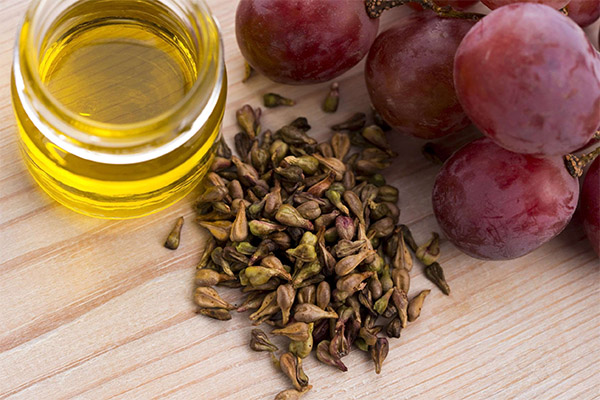
To prepare the oil, choose fresh grapes (red or black, and the second option is considered preferable). Then follow these instructions:
- Separate the grapes from the pips.
- Pips thoroughly washed under running water.
- Dry in an oven at a temperature of 60 ° C, stirring occasionally.
- Dried raw material is ground in a coffee grinder to break the seed coat. The resulting raw material is placed in a glass jar.
- Grinded pips pour quality refined (this is important) sunflower oil, so that it completely covered the raw material. It is even desirable that its level was 4-5 cm higher. Then the mixture is heated in a water bath. The temperature during this procedure should not exceed 70°C. The duration of the process is about 24 hours.
After that the top layer of oil is poured off. This will be homemade grape oil, in fact - the extract of the seeds. The described heating in a water bath is repeated three more times. But it should be taken into account that the highest concentration of useful substances will be in the primary extract.
Interesting Facts about Grapes
Grapes are a truly unique plant, all of its parts are beneficial, including leaves, the pulp and skin of berries and even its seeds. Currently there are over 5000 varieties of cultivated grapes in the world. Of this number, 85% are bred for wine production and only 12% are table varieties. The remaining varieties are seedless grapes used to make raisins. This division, however, is largely arbitrary. Table grapes have larger berries and a sweet taste without tart notes, but both table and raisin varieties can be eaten.
Chemically, grapes are a very complex combination of active substances. In total, there are more than 150 of them. Because of this at one time there was even a separate direction in medicine - ampelotherapy, that is, treatment with grapes. In the ancient era, patients drank grape juice according to the schedule, just like now "Narzan" or "Borjomi".
Ampelotherapy is still evolving today, with seeds playing an increasingly important role. They make up 20-30% of grape extracts. Interestingly, not all of them are used to produce grape oil. Some become the raw material for coffee surrogate.
Interestingly, the grapevine can even be grown from an ordinary seed. But this is the only way to get a seedling. Varietal plants retain their properties only when propagated by cuttings.
«Important: All information on this site is provided for informational purposes only. for informational purposes only. Please consult with your health care professional before using any of the recommendations. specialist before using any of the recommendations. Neither the editors nor the authors shall be liable for any possible harm caused by materials."



